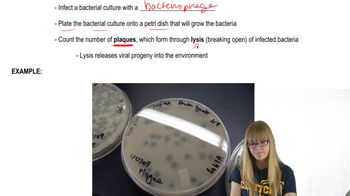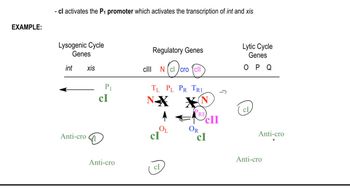Write a short summary that contrasts how recombination occurs in bacteria and bacteriophages.
Table of contents
- 1. Introduction to Genetics51m
- 2. Mendel's Laws of Inheritance3h 37m
- 3. Extensions to Mendelian Inheritance2h 41m
- 4. Genetic Mapping and Linkage2h 28m
- 5. Genetics of Bacteria and Viruses1h 21m
- 6. Chromosomal Variation1h 48m
- 7. DNA and Chromosome Structure56m
- 8. DNA Replication1h 10m
- 9. Mitosis and Meiosis1h 34m
- 10. Transcription1h 0m
- 11. Translation58m
- 12. Gene Regulation in Prokaryotes1h 19m
- 13. Gene Regulation in Eukaryotes44m
- 14. Genetic Control of Development44m
- 15. Genomes and Genomics1h 50m
- 16. Transposable Elements47m
- 17. Mutation, Repair, and Recombination1h 6m
- 18. Molecular Genetic Tools19m
- 19. Cancer Genetics29m
- 20. Quantitative Genetics1h 26m
- 21. Population Genetics50m
- 22. Evolutionary Genetics29m
5. Genetics of Bacteria and Viruses
Bacteriophage Genetics
Problem 12
Textbook Question
Define plaque, lysogeny, and prophage.
 Verified step by step guidance
Verified step by step guidance1
Define 'plaque' as a clear zone on a bacterial lawn where bacteriophages have infected and lysed the bacterial cells, indicating areas of cell destruction caused by viral infection.
Explain 'lysogeny' as a viral life cycle in which the bacteriophage integrates its genome into the host bacterial chromosome, existing in a dormant state without causing immediate lysis of the host cell.
Describe 'prophage' as the viral DNA that has been integrated into the bacterial genome during lysogeny, which can replicate along with the host DNA and remain latent until induced to enter the lytic cycle.
Clarify that plaques are visible evidence of the lytic cycle, whereas lysogeny and prophage represent a dormant phase of the virus within the host.
Summarize the relationship: plaques result from lytic infection, lysogeny is the dormant integration phase, and prophage is the integrated viral DNA within the host genome.
 Verified video answer for a similar problem:
Verified video answer for a similar problem:This video solution was recommended by our tutors as helpful for the problem above
Video duration:
1mPlay a video:
Was this helpful?
Key Concepts
Here are the essential concepts you must grasp in order to answer the question correctly.
Plaque
A plaque is a clear zone formed on a bacterial lawn where bacteriophages have infected and lysed bacterial cells. It represents areas of bacterial cell death caused by viral replication and release, useful for quantifying phage particles.
Recommended video:
Guided course

Plaques and Experiments
Lysogeny
Lysogeny is a viral life cycle in which a bacteriophage integrates its genome into the host bacterial chromosome, remaining dormant as a prophage. The host cell continues to live and reproduce, passing the viral DNA to daughter cells.
Recommended video:
Guided course

Decision Between Lytic and Lysogenic Cycles
Prophage
A prophage is the viral DNA integrated into the bacterial genome during lysogeny. It remains inactive but can later be induced to enter the lytic cycle, producing new phages and lysing the host cell.
Recommended video:
Guided course

Plaques and Experiments

 3:44m
3:44mWatch next
Master Plaques and Experiments with a bite sized video explanation from Kylia
Start learningRelated Videos
Related Practice
Textbook Question
650
views
